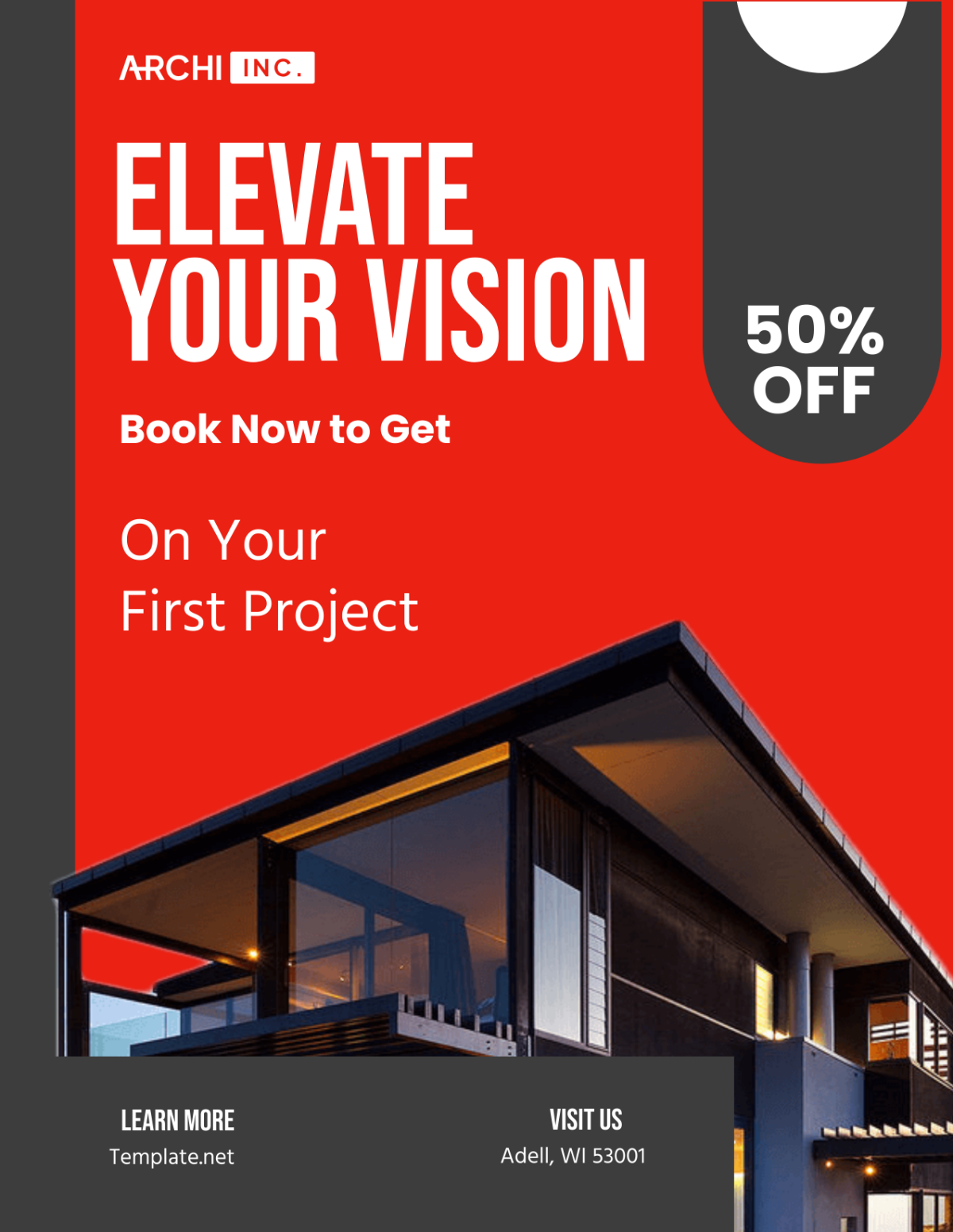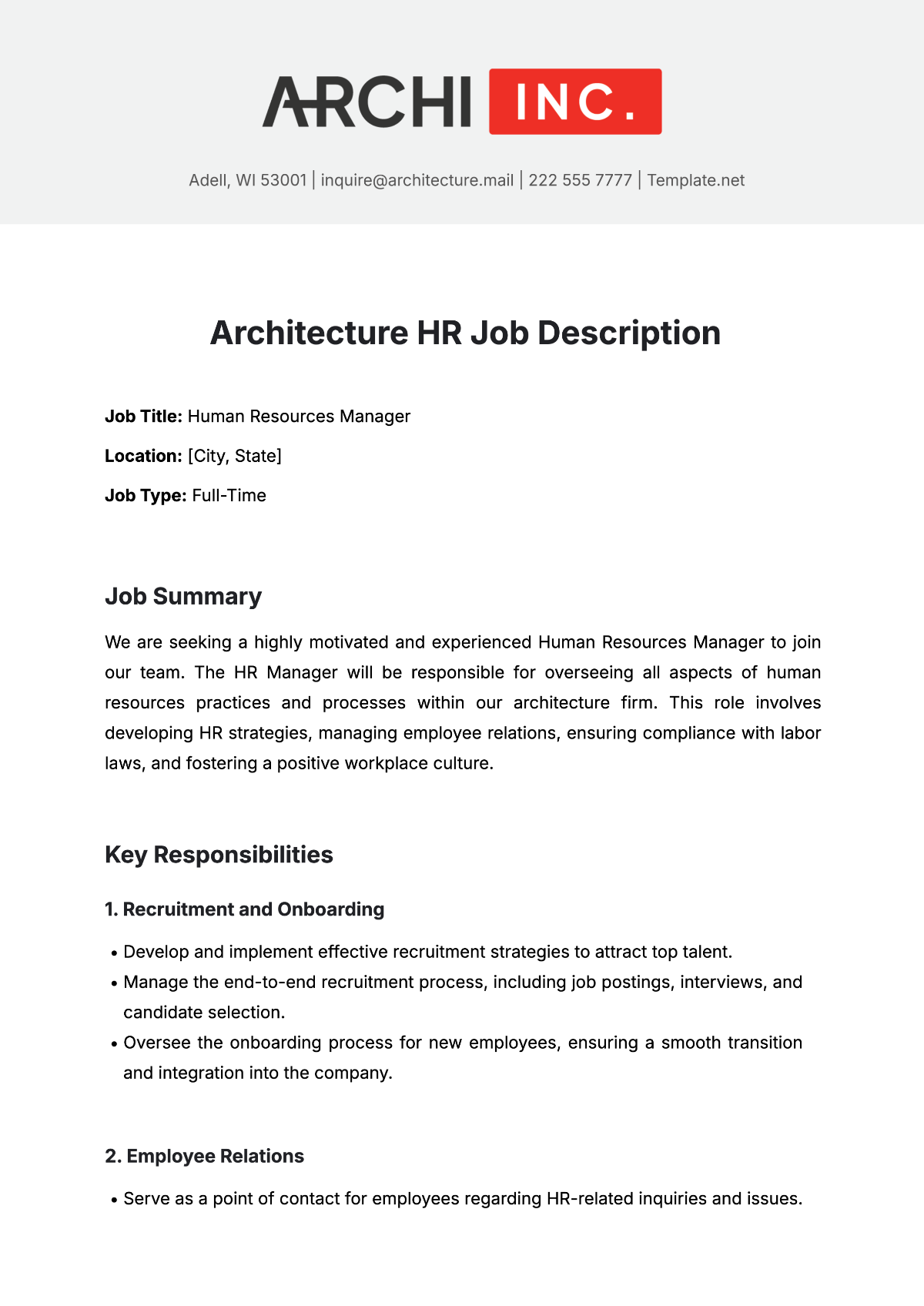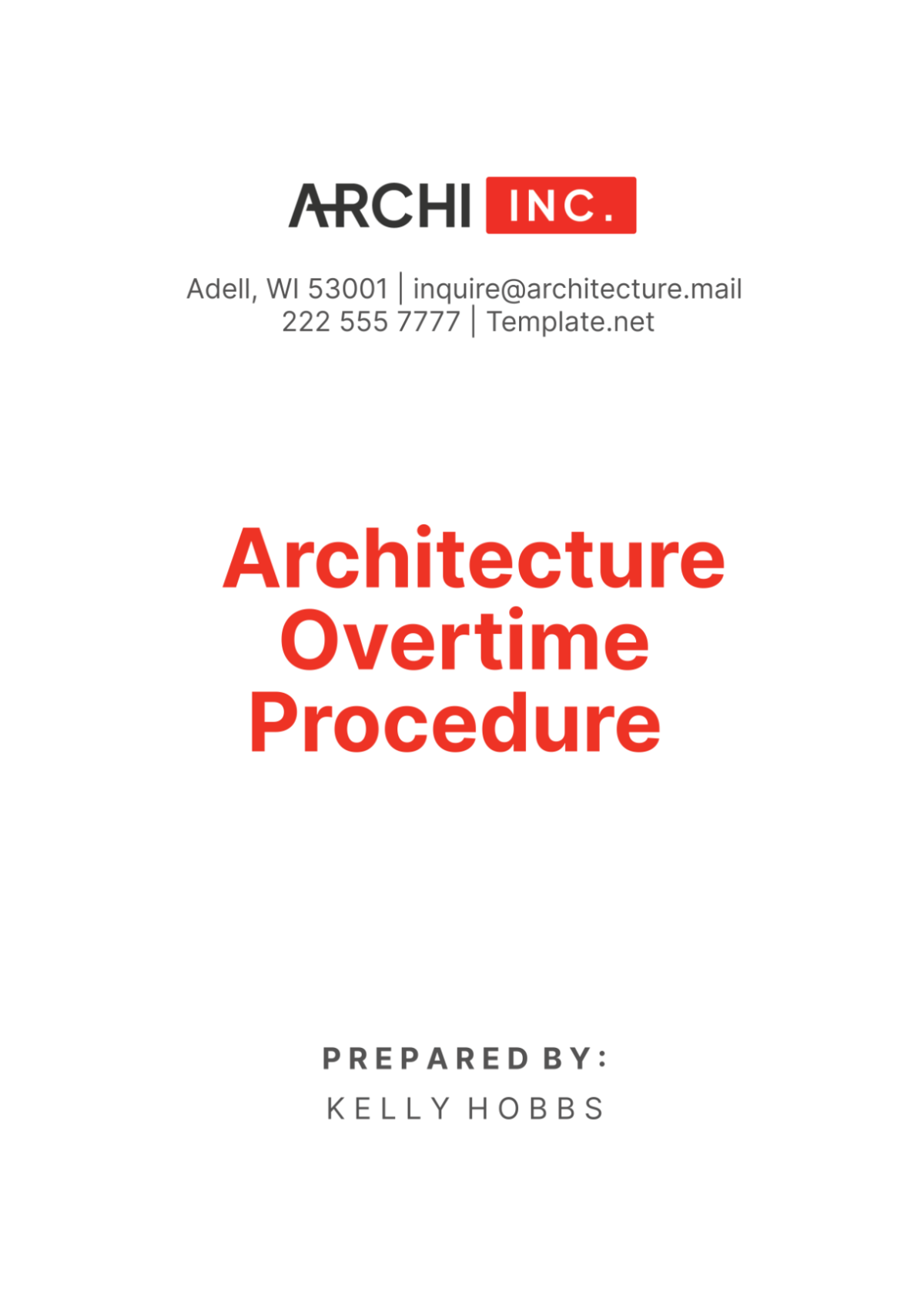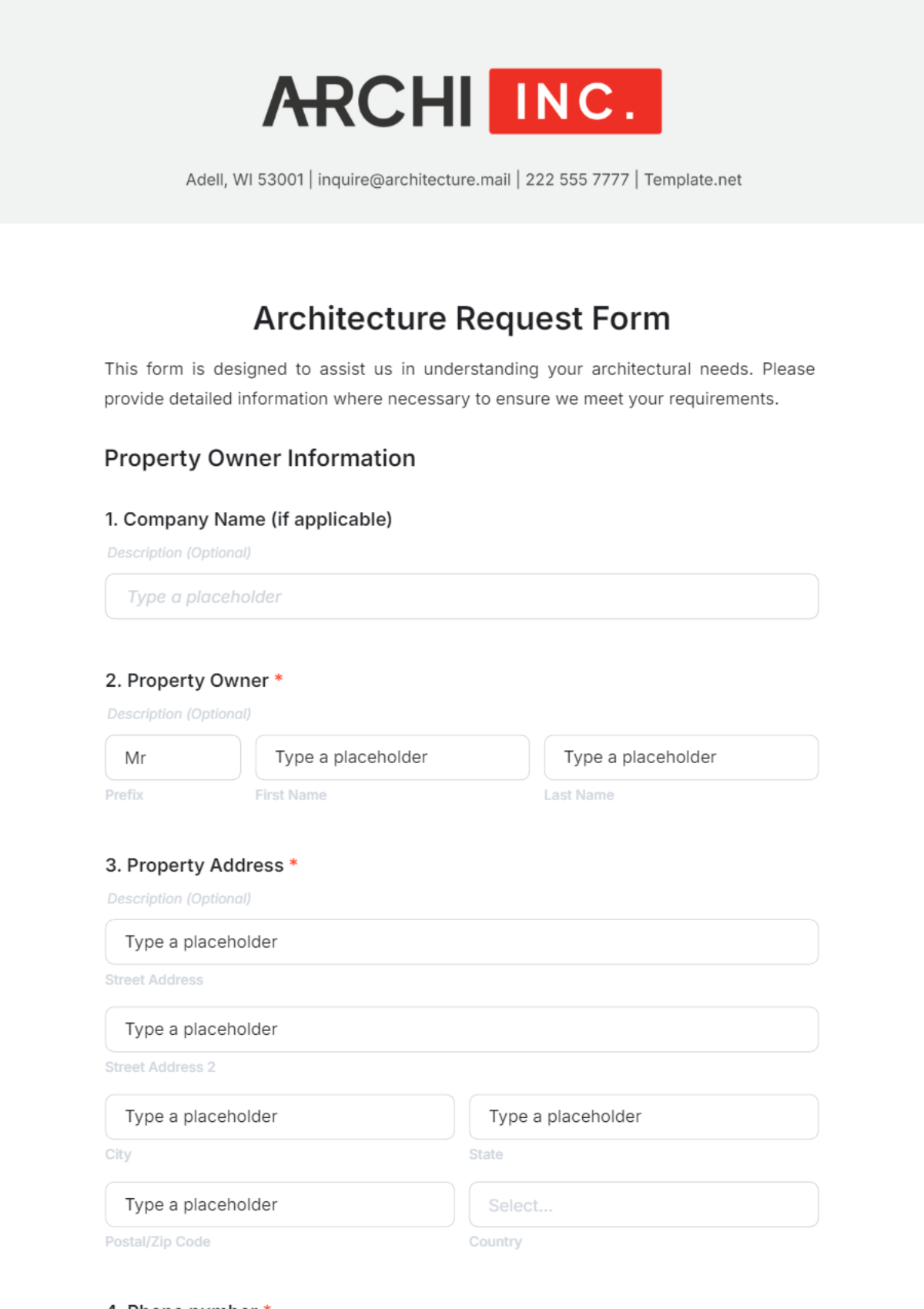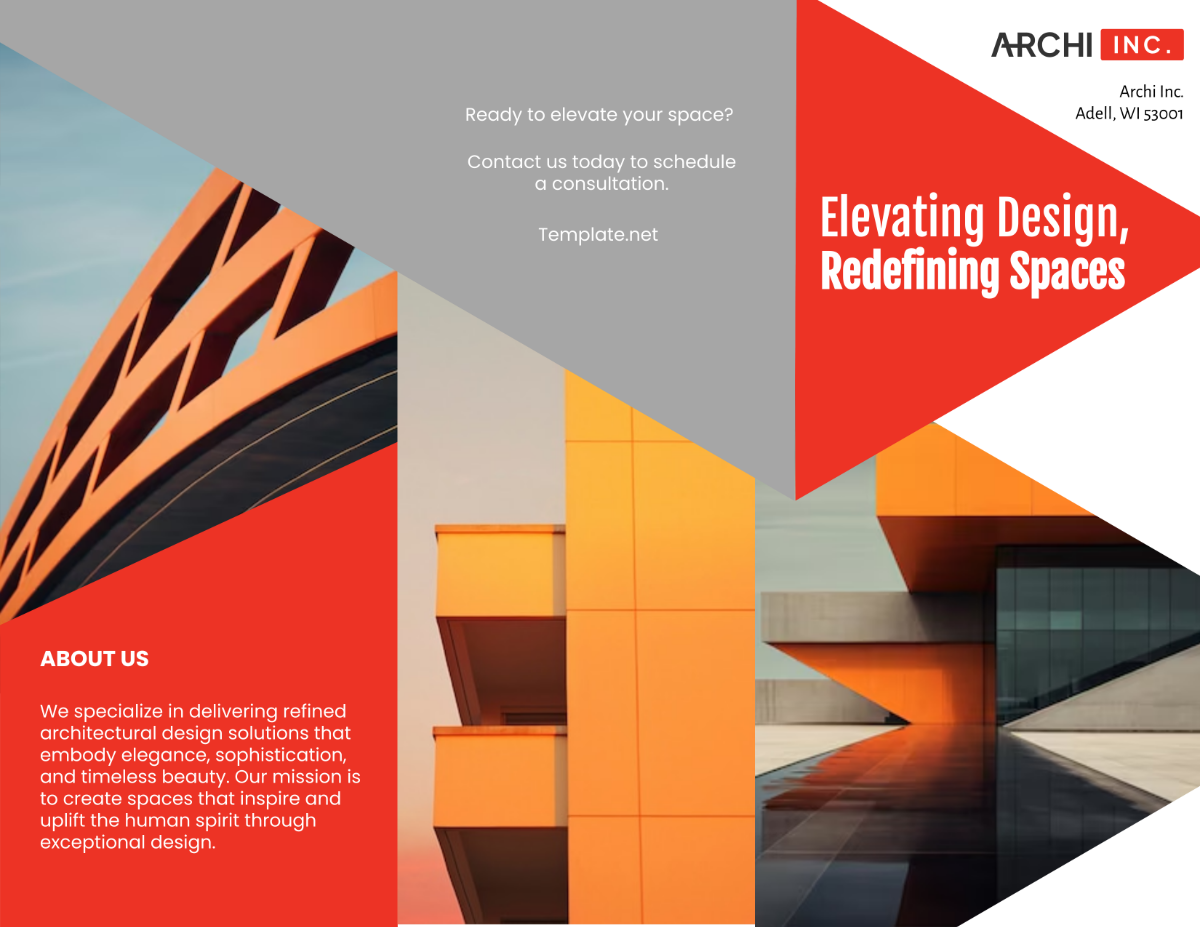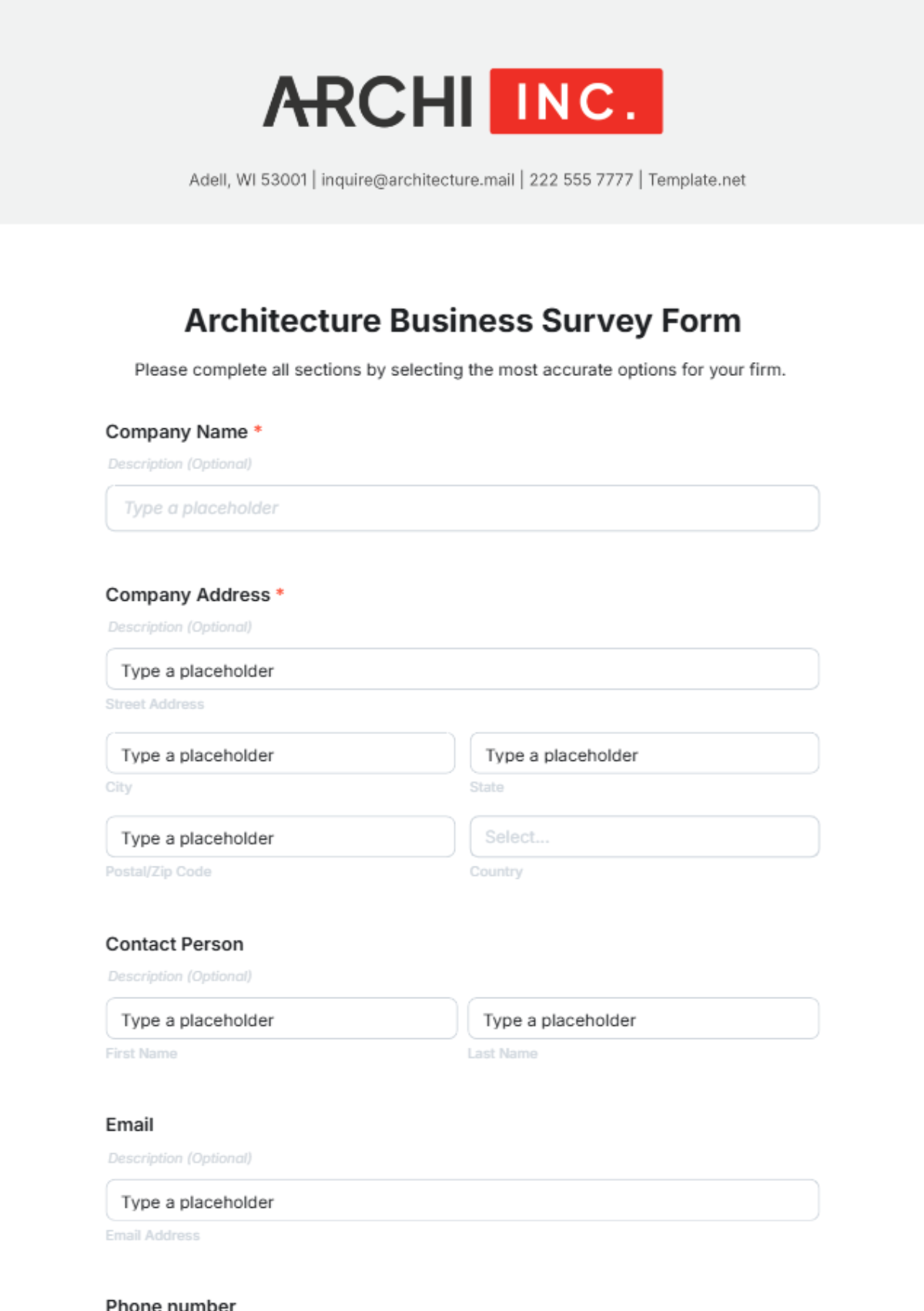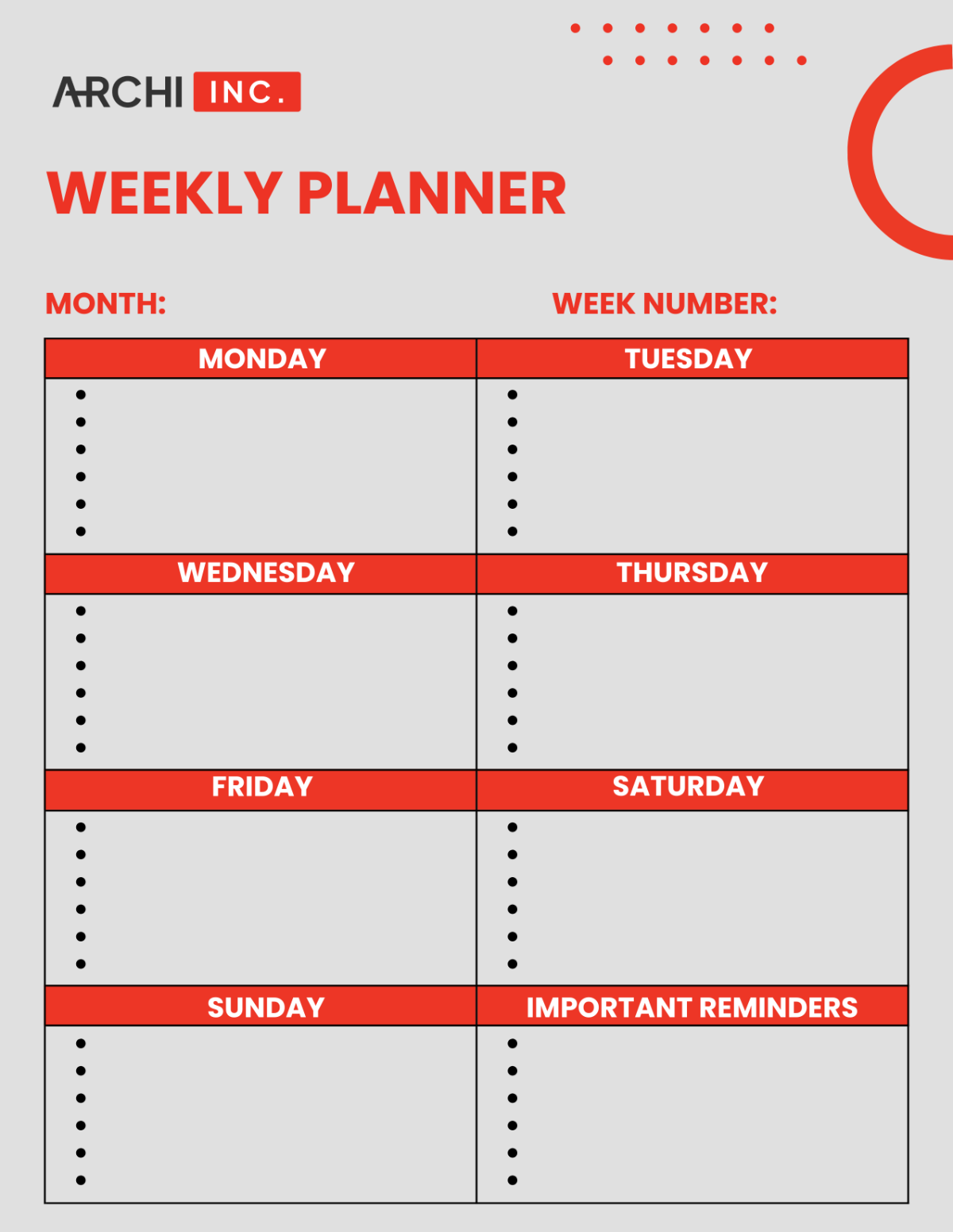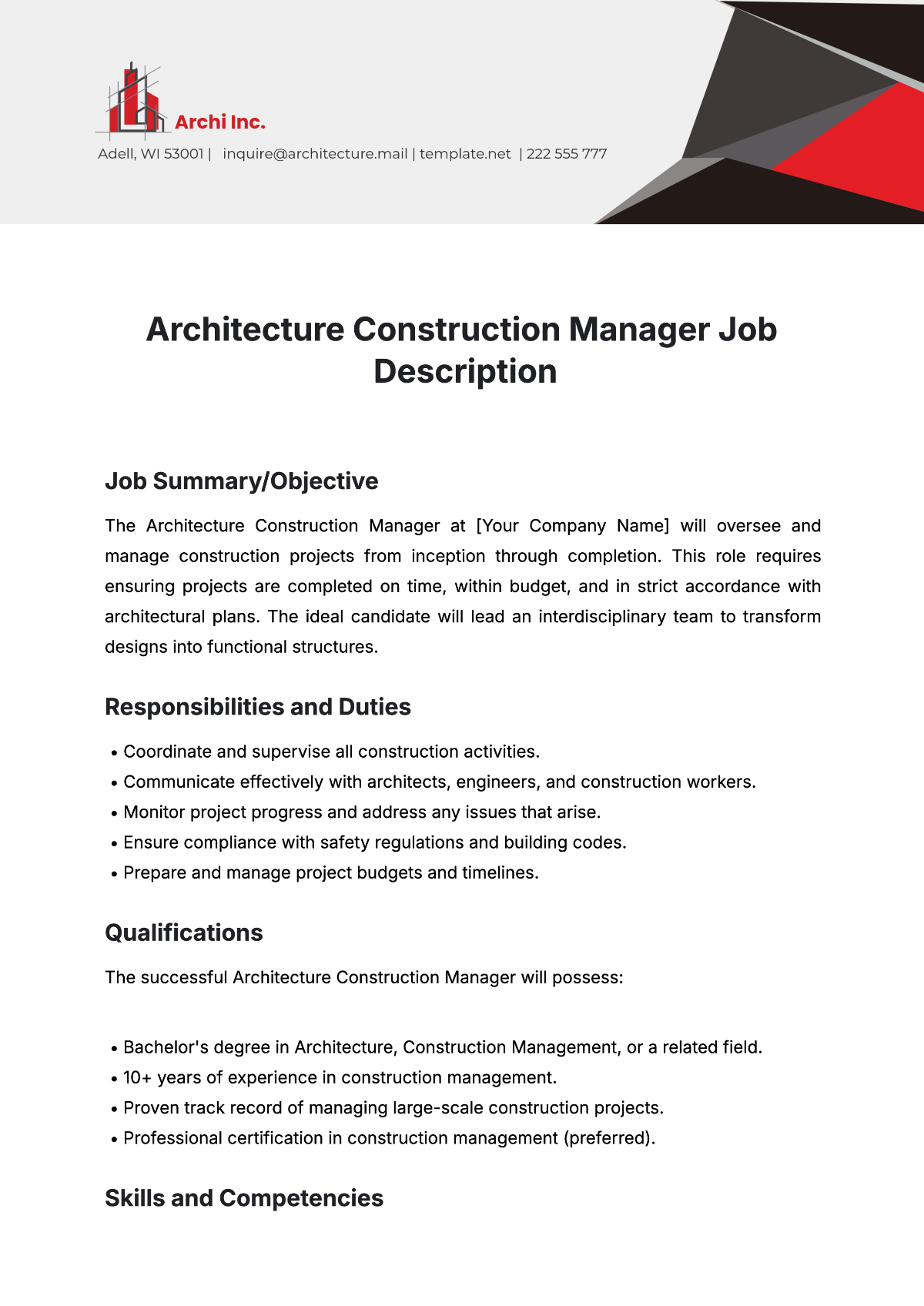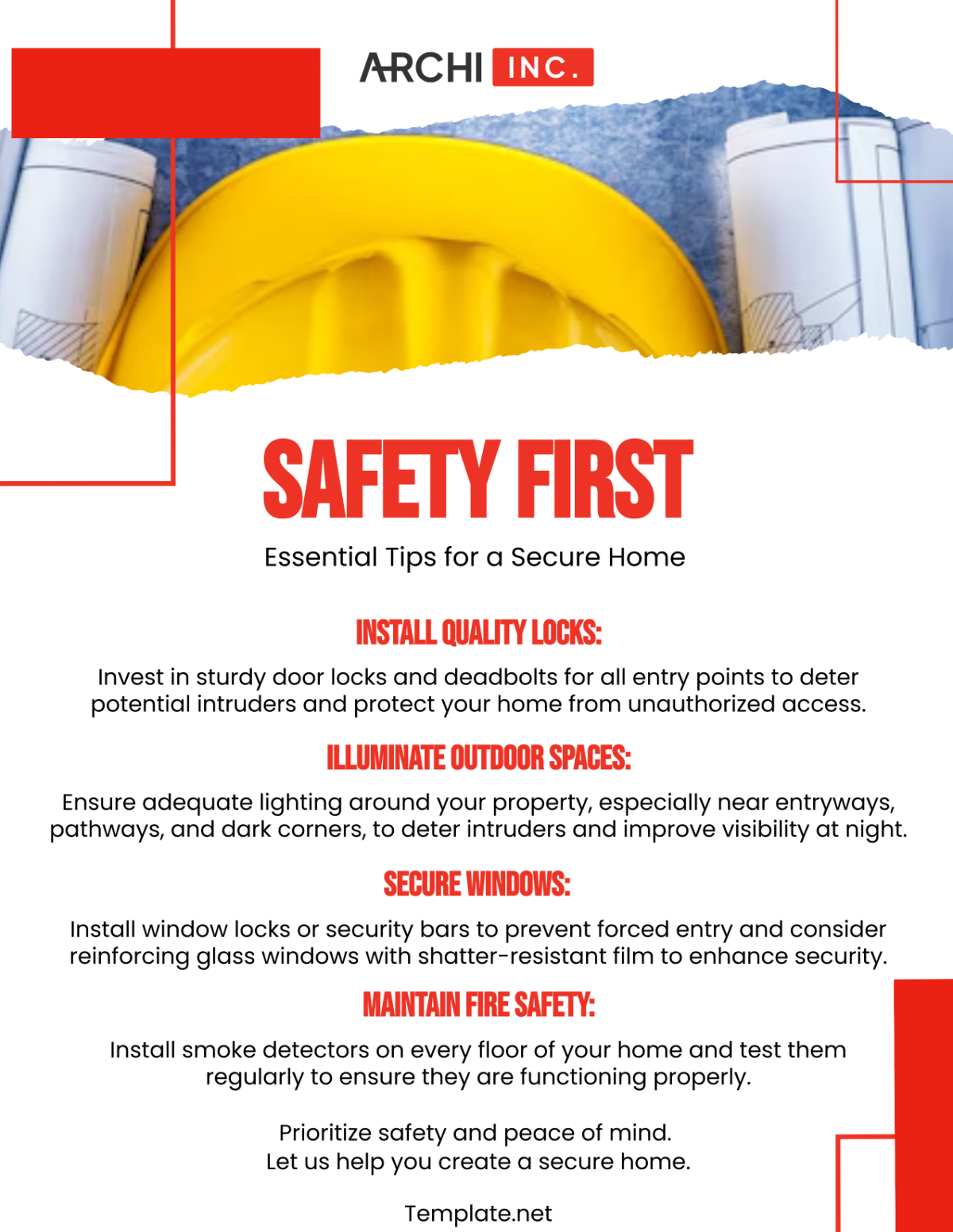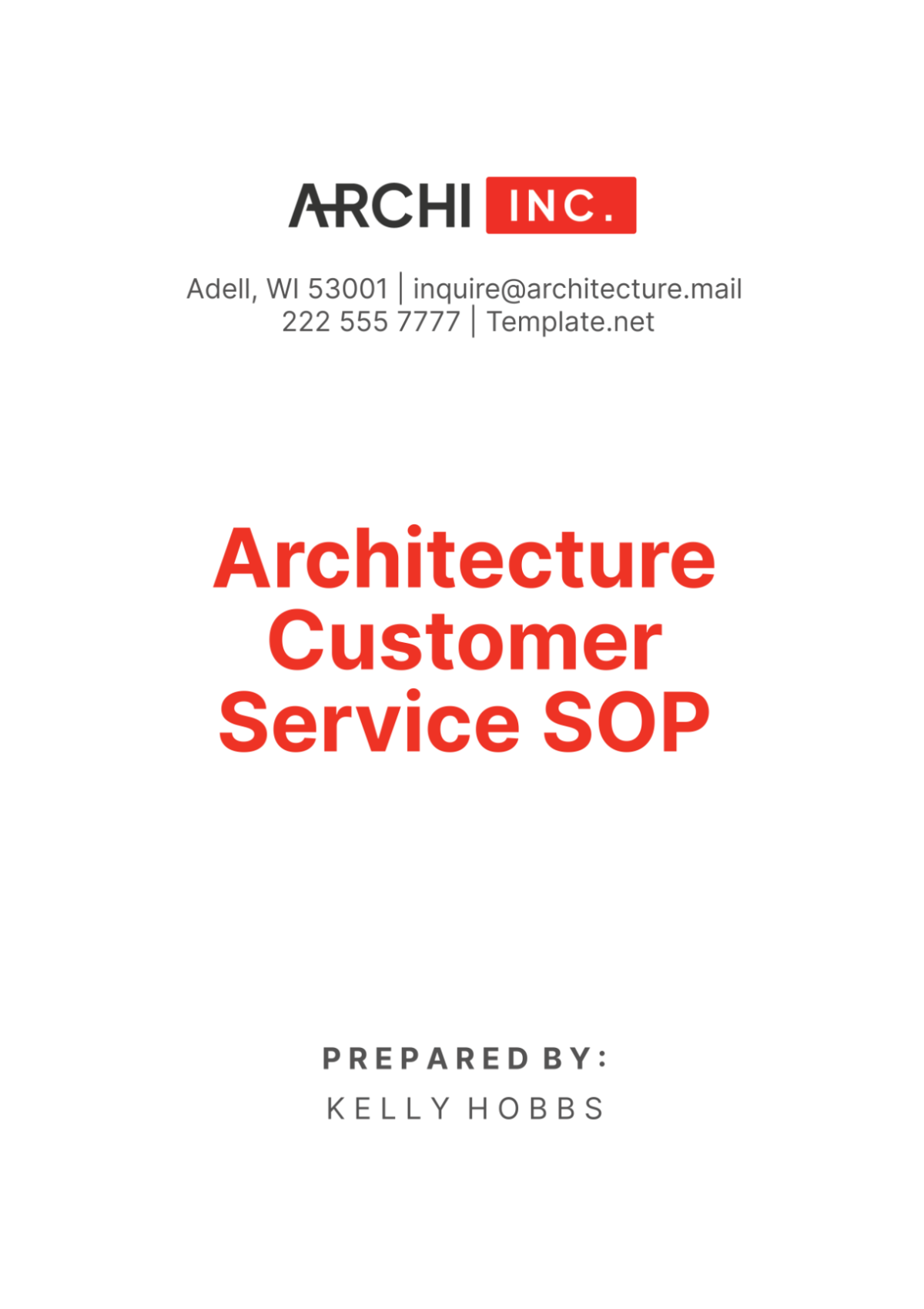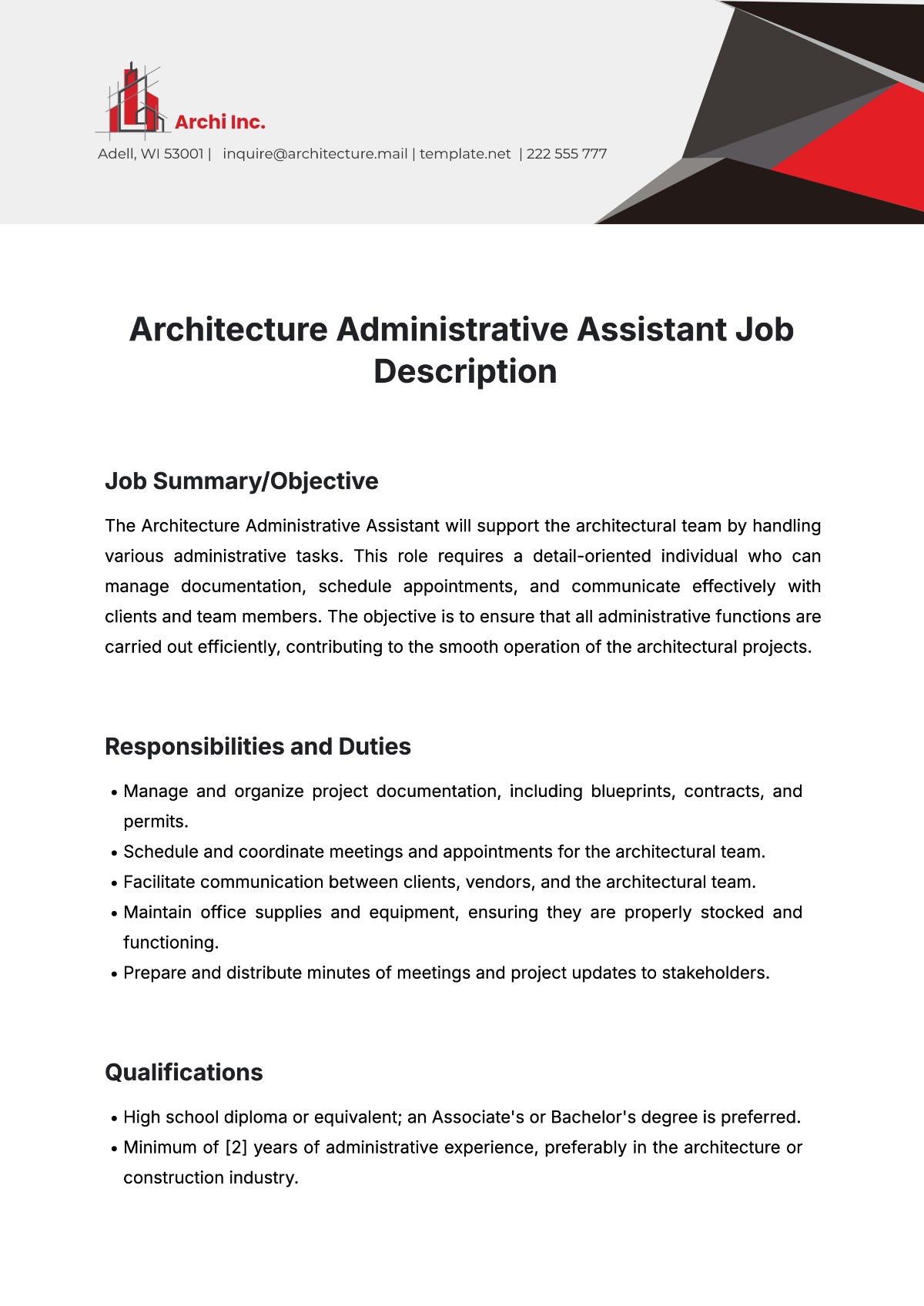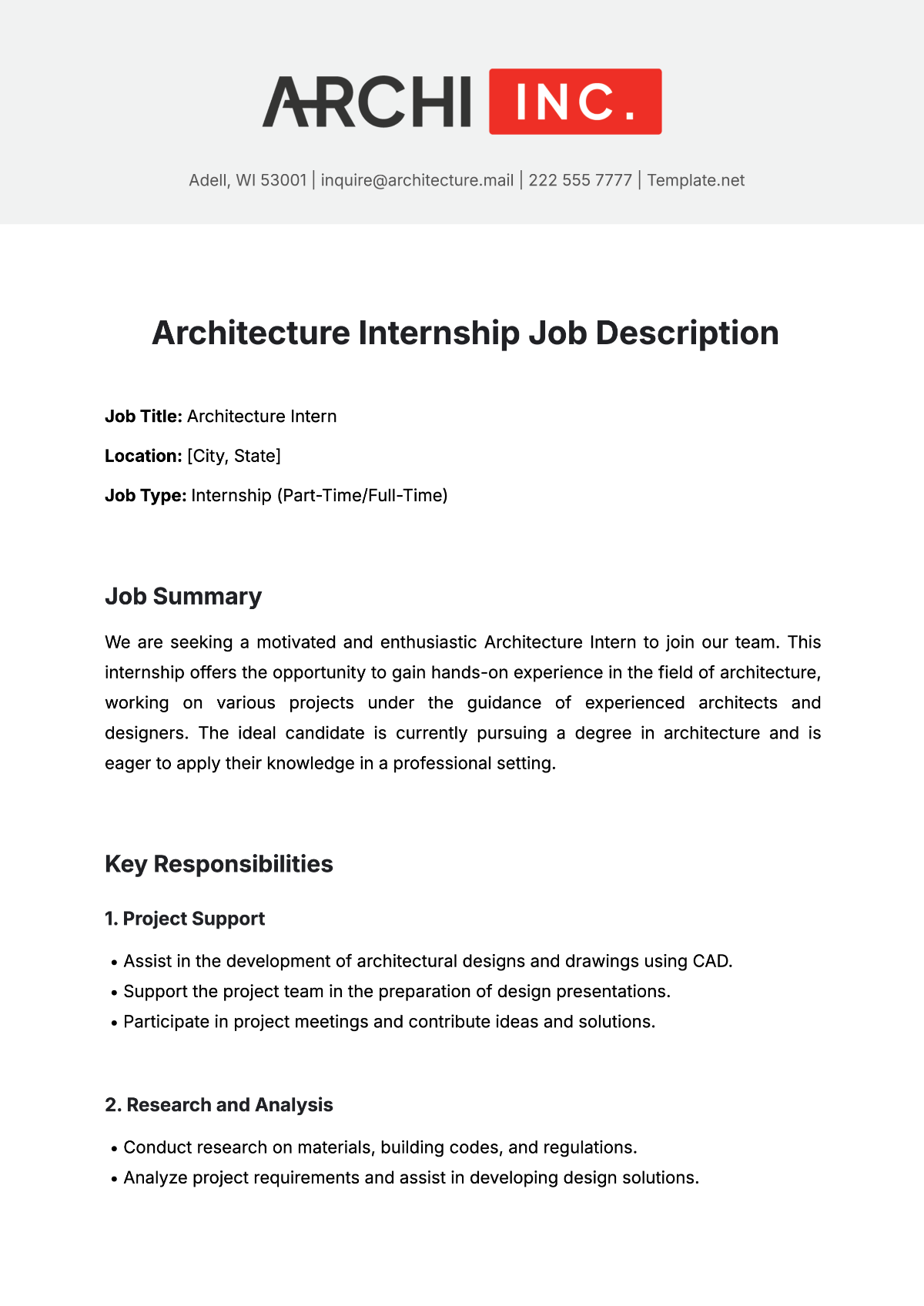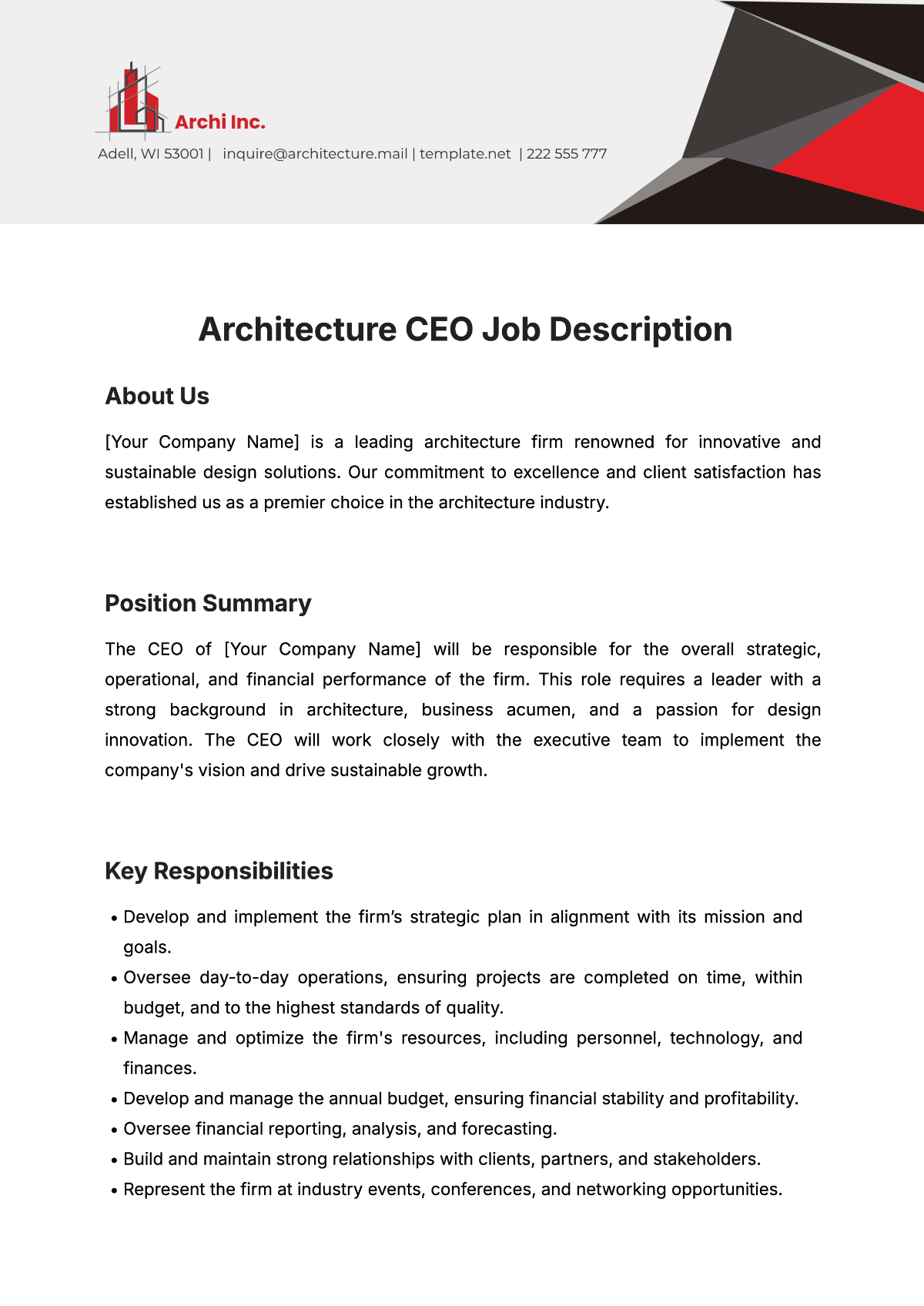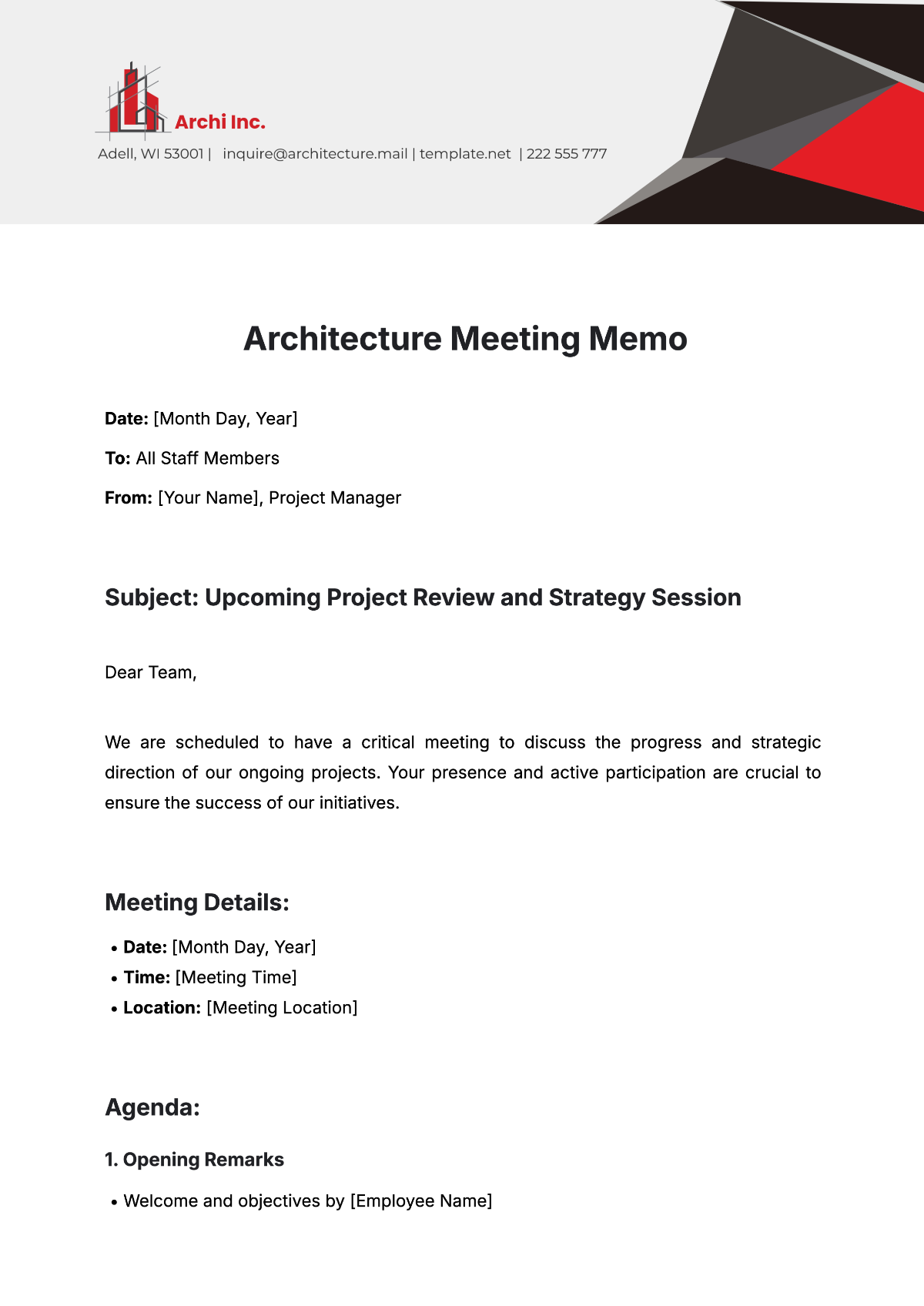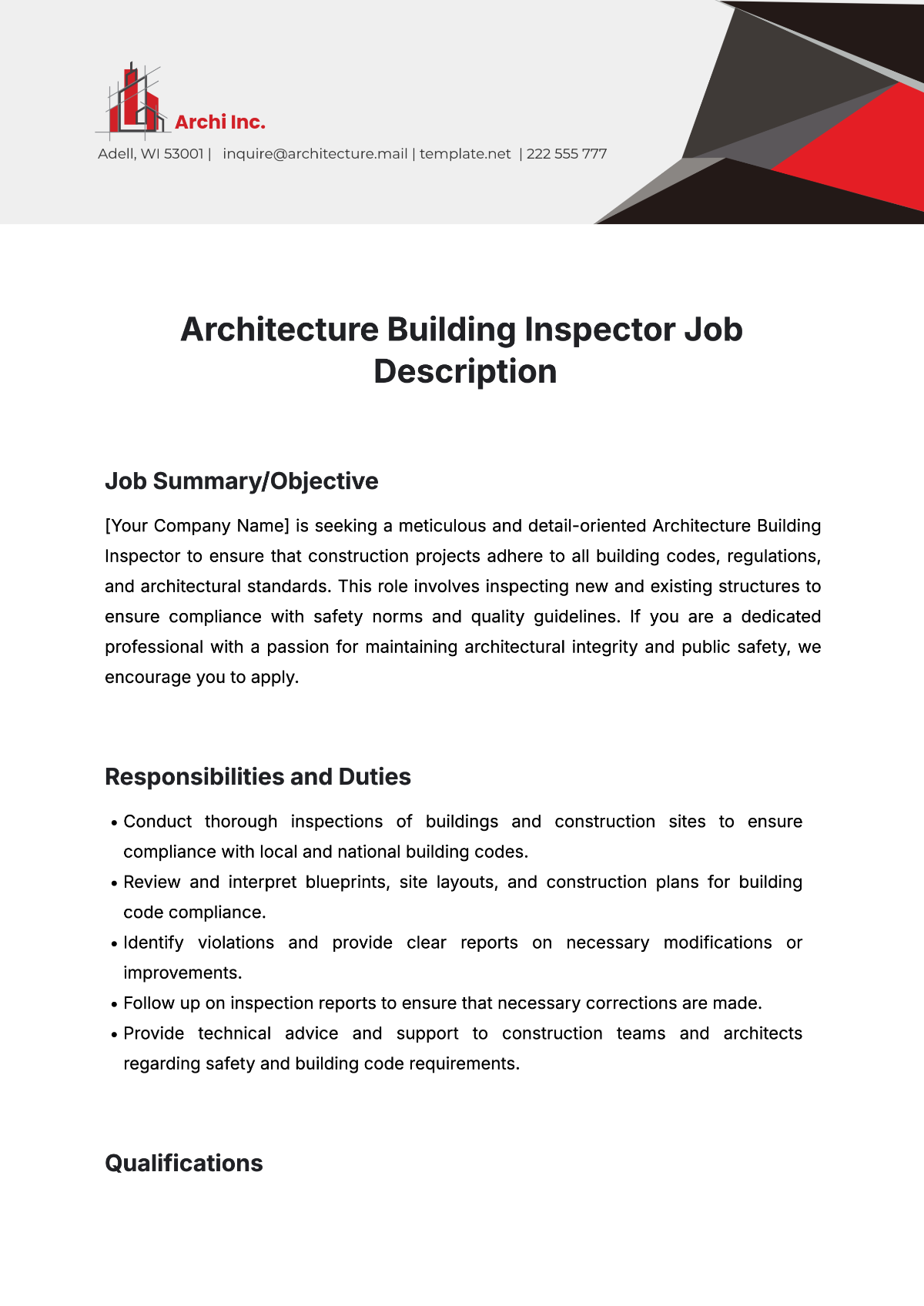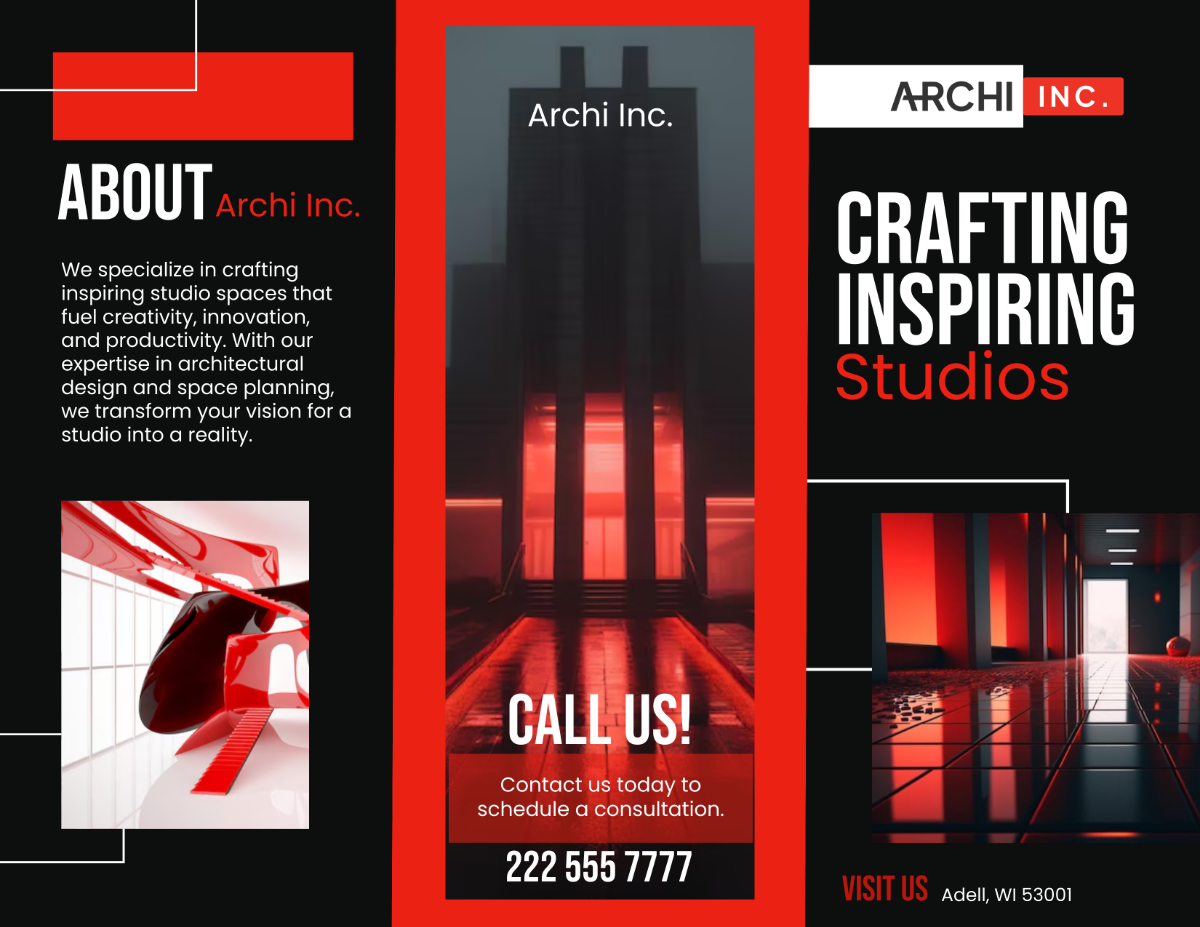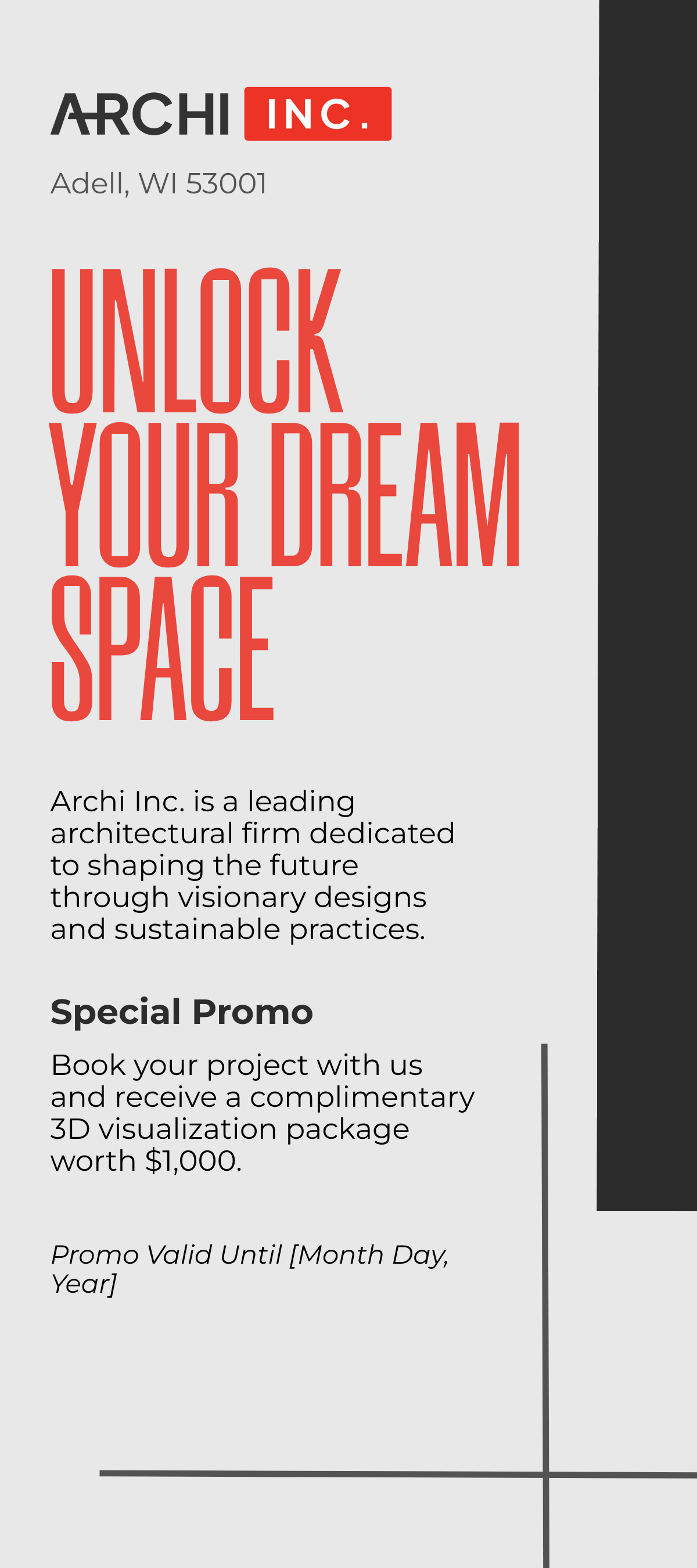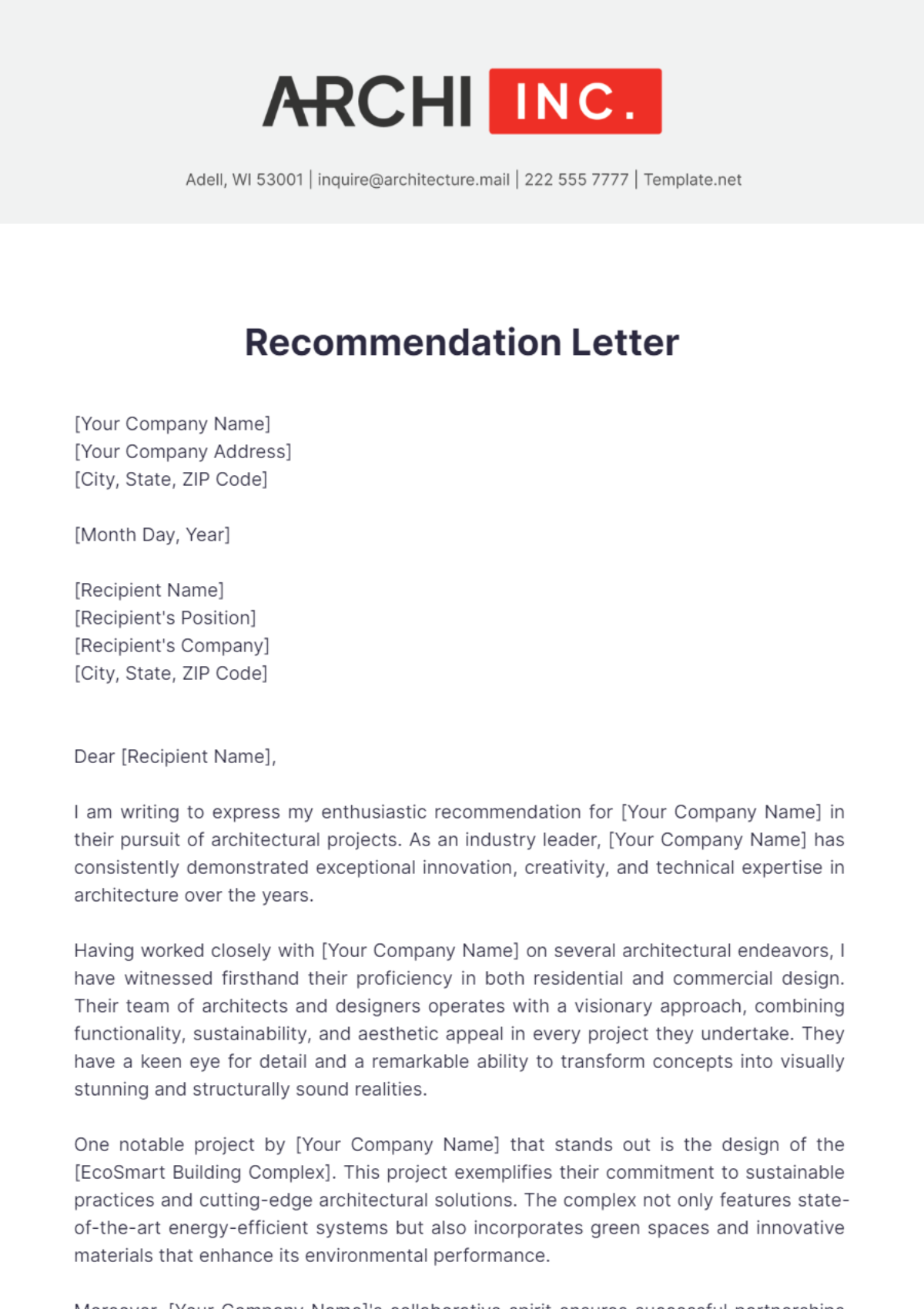Free Architecture Marketing Guide Template
Architecture Marketing Guide
I. Introduction
A. Overview
Effective marketing is essential for the success of any architecture firm. At [Your Company Name], we understand the importance of crafting strategic marketing campaigns that resonate with our target audience. This guide provides a comprehensive approach to developing and executing marketing strategies tailored to our firm's unique strengths and objectives.
Our marketing guide is designed to help our team systematically plan, execute, and evaluate marketing efforts. By following these structured steps, we aim to enhance our visibility, attract new clients, and reinforce our reputation as a leading architecture firm.
B. Target Audience
This guide is intended for various roles within [Your Company Name] to ensure cohesive and comprehensive marketing efforts:
Marketing Team: The marketing team is responsible for creating and implementing marketing strategies that align with our firm's goals. They will use this guide to develop campaigns, track performance, and make data-driven adjustments.
Architects and Designers: Architects and designers provide critical insights and content for showcasing our projects. Their involvement ensures that the technical and creative aspects of our work are accurately represented in marketing materials.
Sales Team: The sales team utilizes marketing materials to attract and convert potential clients. They rely on this guide to understand the latest marketing strategies and effectively communicate our firm's value proposition.
Management: Management oversees the entire marketing process, ensuring alignment with business goals and providing strategic direction. This guide helps them stay informed about marketing initiatives and their outcomes.
Client Relations Team: The client relations team leverages testimonials and case studies to build client trust. They use this guide to gather and present client feedback in ways that enhance our firm's reputation.
C. Marketing Process
The marketing process at [Your Company Name] involves several key steps, each contributing to a robust and effective marketing strategy. The following table outlines the main steps and their descriptions:
No. | Step | Description |
|---|---|---|
1 | Define Target Audience | Identify the specific audience segments we aim to reach. |
2 | Develop Brand Identity | Create a compelling and consistent brand image. |
3 | Content Creation | Produce engaging and informative content. |
4 | Digital Marketing Strategy | Plan and implement online marketing activities. |
5 | Networking and Partnerships | Build and leverage professional relationships. |
6 | Client Testimonials and Case Studies | Showcase our successful projects and satisfied clients. |
7 | Performance Measurement | Monitor and evaluate the effectiveness of marketing efforts. |
8 | Continuous Improvement | Regularly update and refine marketing strategies. |
The steps outlined are designed to be iterative and adaptable, reflecting the dynamic nature of the architecture market. By continuously assessing and refining our strategies, we can ensure sustained growth and competitiveness.
II. Define Target Audience
Understanding our audience is the first step in any successful marketing campaign. By identifying the specific segments we aim to reach, we can tailor our messaging and strategies to meet their needs effectively.
A. Research Audience Demographics
Conduct surveys and interviews: Gather demographic information through targeted surveys and one-on-one interviews. This data helps us understand the age, gender, income, and location of our potential clients.
Analyze existing client data: Review the demographic data of our current clients to identify common characteristics. This analysis can reveal trends and preferences that inform our marketing strategies.
Use market research tools: Utilize tools like census data, industry reports, and market analysis software to supplement our primary research. These tools provide broader context and additional insights.
Segment the audience: Divide our audience into segments based on demographic factors. This segmentation allows for more personalized and effective marketing messages.
Develop audience personas: Create detailed profiles for each segment, including their demographics, behaviors, and needs. These personas guide our content creation and campaign strategies.
B. Identify Audience Needs and Preferences
Determine pain points: Identify the challenges and pain points faced by our potential clients. Understanding these issues allows us to position our services as solutions.
Assess project and service appeal: Evaluate which types of projects and services are most attractive to different audience segments. This assessment helps prioritize our offerings and tailor our marketing messages.
Collect feedback: Gather input through surveys, focus groups, and direct client interactions. Feedback provides valuable insights into client preferences and satisfaction levels.
Leverage social media: Monitor social media platforms and online forums to understand the interests and discussions of our target audience. This information helps refine our content and engagement strategies.
C. Competitive Analysis
Identify key competitors: List the main competitors within the architecture industry. Understanding their strengths and weaknesses helps us position our firm more effectively.
Analyze competitors' strategies: Study the marketing tactics and campaigns used by our competitors. Analyzing their effectiveness can reveal opportunities and best practices for our own strategies.
Determine market gaps: Identify areas where competitors are lacking or where there is unmet demand. These gaps represent opportunities for differentiation and innovation.
Benchmark our offerings: Compare our services and projects against those of our competitors. Highlight our unique selling points to emphasize what sets us apart in the market.
By thoroughly understanding our target audience and competitors, we can craft marketing strategies that are both targeted and differentiated. This approach ensures that our messaging resonates with the right people and positions our firm as a leader in the architecture industry.
III. Develop Brand Identity
A strong brand identity is crucial for distinguishing [Your Company Name] in the competitive architecture market. It encompasses our visual style, messaging, and overall reputation.
A. Create a Visual Identity
Design a memorable logo: Develop a logo that reflects our firm's values and expertise. A well-designed logo becomes a recognizable symbol of our brand.
Develop a consistent color palette: Choose colors that represent our brand personality and ensure they are used consistently across all materials. A cohesive color palette strengthens brand recognition.
Create branded templates: Design templates for presentations, proposals, and marketing materials. Consistent templates maintain visual coherence and professionalism.
Align visual elements: Ensure all visual elements, including imagery and typography, align with our firm's personality and positioning. This alignment creates a unified brand experience.
B. Craft a Brand Story
Define mission, vision, and values: Clearly articulate our firm's mission, vision, and core values. These statements guide our branding efforts and communicate our purpose.
Write a compelling brand story: Develop a narrative that conveys our firm's journey, achievements, and aspirations. A compelling story connects with our audience on an emotional level.
Incorporate the brand story: Embed our brand story into all marketing materials and communications. Consistent storytelling reinforces our brand message.
Train employees: Educate employees on our brand story and values. Empower them to represent the brand consistently in all interactions.
C. Develop Brand Guidelines
Document standards: Create a comprehensive brand guideline document. Include visual and messaging standards to ensure consistency.
Provide usage guidelines: Outline proper usage for logos, typography, colors, and imagery. Clear guidelines prevent brand misrepresentation.
Include examples: Provide examples of branded materials to illustrate correct usage. Examples help employees and partners understand brand standards.
Update periodically: Regularly review and update the brand guidelines to reflect any changes. Keeping guidelines current ensures they remain relevant and useful.
Establishing a strong and consistent brand identity not only differentiates [Your Company Name] but also builds trust and loyalty among our audience. A well-defined brand identity ensures that all marketing efforts convey a unified and professional image.
IV. Content Creation
Creating valuable and engaging content is key to attracting and retaining clients. Our content should reflect our expertise, showcase our projects, and provide useful information to our audience.
A. Develop a Content Strategy
Identify content themes: Determine the topics that align with our audience's interests and needs. Focusing on relevant themes ensures our content resonates with our target market.
Create an editorial calendar: Plan content production and distribution using an editorial calendar. This tool helps organize our efforts and ensures consistent content delivery.
Allocate resources: Assign writers, designers, and videographers to content creation tasks. Ensuring adequate resources maintains high-quality output.
Set goals and metrics: Define specific goals for each piece of content and establish metrics to measure success. Clear objectives guide our content efforts and enable performance tracking.
B. Produce High-Quality Content
Write engaging articles: Craft blog posts, articles, and case studies that highlight our expertise. Well-written content showcases our knowledge and attracts readers.
Create visual content: Develop infographics, videos, and images to enhance engagement. Visual content is often more engaging and shareable than text alone.
Develop downloadable resources: Produce eBooks, whitepapers, and guides that offer in-depth information. These resources position us as thought leaders and provide value to our audience.
Ensure professional editing: Edit all content to maintain high standards of quality and accuracy. Professional editing ensures clarity and credibility.
C. Optimize Content for SEO (Search Engine Optimization)
Conduct keyword research: Identify relevant keywords and phrases that our audience is searching for. Using these keywords improves our content's search engine visibility.
Incorporate keywords naturally: Integrate keywords into titles, headings, and body text without compromising readability. Natural keyword usage enhances SEO without alienating readers.
Use meta descriptions and alt tags: Write compelling meta descriptions and alt tags for images to improve click-through rates and accessibility. Descriptive meta data enhances our content's visibility in search engine results.
Update and repurpose content: Regularly review and update existing content to reflect changes in keywords and search algorithms. Repurposing content into different formats can also attract new audiences and improve search rankings.
D. Digital Marketing Strategy
An effective digital marketing strategy ensures that our content reaches the right audience through various online channels.
Website Optimization
1.1. Design a user-friendly website: Create a website with intuitive navigation and clear calls-to-action to enhance the user experience.
1.2. Ensure mobile responsiveness: Optimize the website for mobile devices to accommodate users accessing content on smartphones and tablets.
1.3. Implement SEO best practices: Optimize website content, meta tags, and technical elements to improve search engine rankings and visibility.
1.4. Regularly update content: Keep the website content fresh and relevant by publishing new blog posts, project updates, and industry insights.
Social Media Marketing
2.1. Choose the right platforms: Identify the social media platforms where our target audience is most active and maintain a presence on those channels.
2.2. Share valuable content: Regularly post engaging content such as project highlights, industry news, and behind-the-scenes glimpses to foster community engagement.
2.3. Interact with followers: Respond promptly to comments, messages, and inquiries to build rapport with our audience and strengthen relationships.
2.4. Utilize paid advertising: Invest in paid social media advertising to expand our reach and target specific audience segments with tailored messages.
Email Marketing
3.1. Build and segment email lists: Collect email addresses through website sign-ups, events, and lead magnets, and segment the lists based on audience preferences and behaviors.
3.2. Personalize email campaigns: Tailor email content to the interests and needs of different audience segments, using personalized subject lines and messaging to increase engagement.
3.3. Automate email workflows: Set up automated email sequences for lead nurturing, onboarding, and re-engagement to streamline communication and maximize conversions.
3.4. Track and analyze performance: Monitor key email metrics such as open rates, click-through rates, and conversions to measure the effectiveness of campaigns and optimize future efforts.
Online Advertising
4.1. Define campaign objectives: Determine the goals of online advertising campaigns, whether it's to increase brand awareness, generate leads, or drive conversions.
4.2. Select targeting criteria: Identify the target audience based on demographics, interests, and behaviors, and refine targeting parameters to reach the most relevant prospects.
4.3. Create compelling ad creatives: Develop visually appealing ad creatives with persuasive copy that captures attention and communicates our value proposition effectively.
4.4. Monitor and optimize performance: Continuously monitor ad performance metrics such as click-through rates, conversion rates, and return on ad spend (ROAS), and make data-driven adjustments to optimize campaign performance and maximize ROI.
V. Networking and Partnerships
Building and leveraging professional relationships can significantly enhance our marketing efforts and expand our reach.
A. Attend Industry Events
Participate in architecture conferences and trade shows: Engage with industry professionals, showcase our projects, and stay updated on the latest trends and innovations.
Network with potential clients and partners: Build connections with architects, developers, contractors, and other stakeholders to explore collaboration opportunities and generate leads.
Host or sponsor events: Organize workshops, seminars, or networking events to position ourselves as industry leaders and foster relationships with prospects and clients.
Follow up: After the event, follow up with contacts to maintain connections and explore potential collaboration or partnership opportunities.
B. Join Professional Associations
Identify relevant associations: Research and join professional organizations and associations in the architecture and construction industries, such as the American Institute of Architects (AIA) or the National Association of Home Builders (NAHB).
Participate in association activities: Attend meetings, seminars, and networking events to connect with peers, share insights, and stay informed about industry developments.
Leverage association resources: Access resources, publications, and educational opportunities offered by the associations to stay updated on industry best practices and regulations.
Demonstrate expertise: Volunteer for leadership roles or contribute articles, presentations, or workshops to showcase our expertise and establish credibility within the industry.
C. Collaborate with Partners
Identify potential partners: Identify complementary businesses and professionals in related fields, such as interior designers, landscape architects, or structural engineers.
Establish mutually beneficial partnerships: Explore collaboration opportunities, such as joint projects, co-marketing initiatives, or referral arrangements, that offer value to both parties involved.
Develop partnership agreements: Clearly define roles, responsibilities, and expectations in written agreements to ensure a smooth and mutually beneficial collaboration.
Communicate and coordinate: Maintain open communication and regular coordination with partners to ensure alignment and maximize the effectiveness of joint efforts.
D. Leverage Client Relationships
Maintain regular communication: Stay in touch with past and current clients through emails, newsletters, and social media to nurture relationships and stay top-of-mind.
Request referrals and testimonials: Ask satisfied clients for referrals and testimonials to leverage their positive experiences and expand our client base.
Invite clients to events: Extend invitations to clients for industry events, project unveilings, or networking opportunities to strengthen relationships and foster loyalty.
Provide value-added services: Offer additional services, resources, or incentives to clients to demonstrate our commitment to their success and enhance their experience working with us.
VI. Client Testimonials and Case Studies
Showcasing successful projects and satisfied clients builds trust and credibility. Client testimonials and case studies are powerful tools for demonstrating our firm's capabilities.
A. Collect Client Testimonials
Request testimonials: Reach out to satisfied clients and ask them to provide feedback on their experience working with us.
Conduct interviews: Schedule interviews or surveys to gather detailed testimonials that highlight specific aspects of our service and expertise.
Highlight positive experiences: Showcase testimonials that emphasize our professionalism, responsiveness, and ability to deliver results.
Share testimonials: Feature client testimonials prominently on our website, marketing materials, and social media platforms to build credibility and trust with potential clients.
B. Develop Case Studies
Select notable projects: Choose projects that represent our firm's expertise, innovation, and success stories.
Outline project details: Document the project's objectives, challenges, solutions, and outcomes in a detailed case study format.
Include client feedback: Incorporate quotes and testimonials from clients to provide firsthand insights into their experience working with us.
Showcase results: Highlight the tangible results achieved through our services, such as improved functionality, cost savings, or design accolades.
C. Use Visual Content
Create video testimonials: Produce video testimonials featuring clients discussing their experience working with us, which adds authenticity and emotional appeal to our marketing efforts.
Develop project showcases: Create visually appealing slideshows or presentations showcasing our projects, including before-and-after visuals, design sketches, and finished photographs.
Share project walkthroughs: Create virtual tours or 3D renderings of our projects to provide clients with an immersive experience and showcase our design expertise.
Utilize infographics: Develop infographics summarizing key project details, such as project goals, timelines, and outcomes, in a visually engaging and easy-to-understand format.
Visual content is highly engaging and memorable, making it an effective tool for capturing audience attention and conveying complex information. By incorporating visual elements into our marketing materials, we can effectively showcase our projects and highlight the value we bring to clients.
VII. Performance Measurement
Tracking and evaluating the effectiveness of our marketing efforts is crucial for optimizing strategies and maximizing return on investment (ROI). Key Performance Indicators (KPIs) provide valuable insights into the success of our marketing campaigns, helping us identify areas for improvement and measure progress towards our goals.
A. Website Metrics
Effective website metrics are essential for understanding user behavior, identifying areas of improvement, and optimizing our online presence. The following table outlines the key website KPIs we track, along with their benchmarks:
KPI | Benchmark |
|---|---|
Traffic | Increase by 20% annually |
Engagement | Bounce rate below 40% |
Conversions | Conversion rate of 5% |
Traffic: Monitoring website traffic helps us gauge the effectiveness of our marketing efforts in driving visitors to our site. An increase in traffic indicates that our campaigns are resonating with our target audience and generating interest in our services. By setting a benchmark for traffic growth, we can track our progress over time and identify trends that inform future strategies.
Engagement: Understanding user engagement metrics such as bounce rate and average session duration provides insight into the quality of our website content and user experience. A low bounce rate indicates that visitors are finding our site relevant and engaging, while a high average session duration suggests that users are spending more time exploring our content. By benchmarking these metrics, we can identify areas for improvement and optimize our website to keep visitors engaged.
Conversions: Conversion metrics, such as form submissions, email sign-ups, and downloads, are critical for measuring the effectiveness of our website in driving desired actions. A high conversion rate indicates that our website is effectively persuading visitors to take the next step in their journey, whether it's contacting us for more information or requesting a consultation. By setting a benchmark for conversion rates, we can track our performance and implement strategies to improve conversion rates over time.
Tracking these website KPIs allows us to make data-driven decisions and optimize our online presence to better serve our audience and achieve our marketing objectives. By regularly monitoring these metrics and comparing them against benchmarks, we can identify areas for improvement and implement strategies to enhance the effectiveness of our website.
B. Social Media Analytics
Effective social media analytics provide insights into audience engagement, brand visibility, and content performance. The following table presents the key social media KPIs we track to evaluate the performance of our social media marketing efforts:
KPI | Benchmark |
|---|---|
Reach | Increase by 15% quarterly |
Engagement | Engagement rate of 3% |
Referral traffic | 20% of total website traffic |
Reach: Monitoring the reach of our social media posts allows us to assess our brand's visibility and audience engagement. Increasing reach indicates that our content is resonating with our target audience and attracting new followers. By setting a benchmark for quarterly reach growth, we can track our progress and adjust our content strategy to optimize reach.
Engagement: Engagement metrics, such as likes, comments, and shares, provide insights into the level of interaction and interest generated by our social media content. A high engagement rate indicates that our content is compelling and resonates with our audience. By aiming for a target engagement rate, we can focus on creating content that encourages active participation and fosters community engagement.
Referral traffic: Tracking referral traffic from social media platforms to our website helps us measure the effectiveness of our social media efforts in driving website visits and conversions. Increasing referral traffic indicates that our social media content is driving users to our website, where they can learn more about our services and engage further. By setting a benchmark for the percentage of total website traffic from social media referrals, we can assess the impact of our social media marketing on overall website performance.
C. Email Marketing Metrics
Email marketing metrics provide insights into the effectiveness of our email campaigns, helping us evaluate engagement levels, conversion rates, and overall campaign performance. The following table outlines the key email marketing KPIs we track to measure the performance of our email campaigns:
KPI | Benchmark |
|---|---|
Open rate | Open rate of 25% |
Click-through rate | CTR of 3% |
Conversion rate | Conversion rate of 10% |
Open rate: The open rate indicates the percentage of recipients who open our email campaigns. A high open rate suggests that our subject lines are compelling and our emails are relevant to our audience. By aiming for a benchmark open rate of 25%, we ensure that our emails are being effectively delivered to our subscribers' inboxes and capturing their attention. Monitoring open rates allows us to gauge the overall effectiveness of our email marketing efforts and identify opportunities for improvement in our messaging and targeting strategies.
Click-through rate (CTR): The click-through rate measures the percentage of recipients who click on links within our emails. A high CTR indicates that our email content is engaging and persuasive, encouraging recipients to take action. By setting a benchmark CTR of 3%, we aim to drive meaningful interactions with our email campaigns and guide recipients towards our desired conversion goals. Analyzing CTRs allows us to identify which email content resonates most with our audience and optimize future campaigns to increase engagement and conversions.
Conversion rate: The conversion rate reflects the percentage of recipients who take a desired action, such as making a purchase or filling out a form, after clicking on a link in our emails. A high conversion rate indicates that our email campaigns are effectively driving recipients towards our intended goals and generating tangible results. By aiming for a benchmark conversion rate of 10%, we ensure that our email content is not only engaging but also persuasive enough to prompt recipients to take action. Monitoring conversion rates allows us to assess the overall impact of our email marketing efforts on driving business outcomes and refine our strategies to maximize conversions.
Tracking these email marketing KPIs provides valuable insights into the performance of our campaigns and helps us make data-driven decisions to optimize our email marketing strategy. By regularly monitoring open rates, CTRs, and conversion rates and comparing them against benchmarks, we can identify areas for improvement, test new approaches, and ultimately achieve greater success in engaging our audience and driving meaningful actions.
VIII. Continuous Improvements
Continuous improvement is essential for staying ahead in the competitive landscape of architecture marketing. By regularly evaluating our strategies and adapting to changing trends, we can enhance our effectiveness and achieve greater success in reaching our target audience.
A. Data Analysis and Insights
Regularly analyze performance metrics: Review website analytics, social media insights, and email marketing data to identify trends and patterns in audience behavior.
Gain actionable insights: Extract actionable insights from data analysis to inform future marketing strategies and campaign optimizations.
Benchmark against industry standards: Compare our performance metrics with industry benchmarks to assess our competitiveness and identify areas for improvement.
B. Experimentation and Testing
Test new strategies and tactics: Implement A/B tests and experiments to evaluate the effectiveness of different marketing approaches.
Iterate based on results: Use test results to refine our strategies and tactics, focusing on what resonates best with our audience.
Stay agile and adaptive: Remain flexible and open to innovation, continuously seeking new ways to improve our marketing efforts.
C. Client Feedback and Satisfaction
Solicit client feedback: Regularly gather feedback from clients through surveys, interviews, and reviews to understand their needs and preferences.
Address concerns and suggestions: Actively address client concerns and suggestions to enhance their satisfaction and strengthen client relationships.
Implement improvements based on feedback: Use client feedback to identify areas for improvement in our services and marketing communication, prioritizing enhancements that align with client expectations.
D. Professional Development
Stay updated on industry trends: Invest in ongoing learning and professional development to stay informed about the latest trends and innovations in architecture marketing.
Attend workshops and conferences: Participate in industry events, workshops, and conferences to network with peers and gain valuable insights from thought leaders.
Encourage team collaboration: Foster a culture of collaboration and knowledge sharing within our marketing team, encouraging team members to share insights and best practices.
IX. Key Points
Here are the key points of the guide:
Regularly analyze performance metrics to gain actionable insights into audience behavior and campaign effectiveness.
Experiment with new strategies and tactics, using A/B testing and experimentation to refine our approach.
Solicit client feedback to understand their needs and preferences, addressing concerns and suggestions to enhance satisfaction.
Stay updated on industry trends and invest in ongoing professional development to remain competitive.
Benchmark our performance against industry standards to assess our competitiveness and identify areas for improvement.
Prioritize continuous improvement and adaptation to changing market dynamics to maintain a competitive edge.
Foster a culture of collaboration and innovation within our marketing team, encouraging team members to share insights and ideas.
Implement improvements based on data-driven analysis, client feedback, and experimentation to optimize our marketing strategies.
Stay agile and adaptive, remaining flexible in our approach to meet evolving client needs and market trends.
Focus on delivering value to our clients and stakeholders, ensuring that our marketing efforts align with their goals and expectations.
